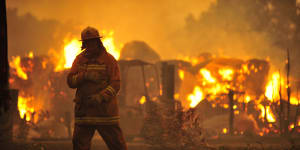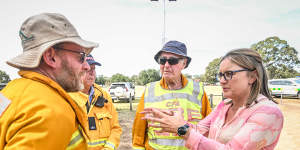As the state deals with the fallout from and with hot weather forecast later this week,Premier Jacinta Allan on Sunday said Victoria would also push the Commonwealth and other states for a national strategy that could force telecommunications companies to better prevent and respond to outages.

Jack Rush,KC,pictured in 2017,says there has been a failure to properly address Victoria’s fire threats.Michael Clayton-Jones
Jack Rush,KC,a former Supreme Court judge who was praised for his role as counsel assisting,toldThe Age that not enough had been done to improve the state’s electricity infrastructure as recommended by the royal commission. The Black Saturday bushfires cost 173 lives and razed more than 450,000 hectares across the state.
Fallen powerlines started several of the deadly blazes in 2009,and Rush said it was “incomprehensible” more had not been done to improve a degraded network.
“There has been a complete failure to properly address what we know from our history is so important,” he said.
“Everyone appreciated that it couldn’t happen immediately,but the lack of rollout is another sign for the way in which history and tragedy is just ameliorated by time. It is incomprehensible after our fire history over the past 15 years.”
Residents of a small town hardest hit by wild weather have called for support.
The 2009 investigation called for the “the progressive replacement of all single-wire earth return powerlines in Victoria with aerial bundled cable,underground cabling or other technology that delivers greatly reduced bushfire risk”.
“The replacement program should be completed in the areas of highest bushfire risk within 10 years and should continue in areas of lower bushfire risk as the lines reach the end of their engineering lives,” said.
Across the royal commission identified,about 19 per cent of the single-wire earth return line managed by Ausnet has been replaced. For lines managed by Powercor,the figure is 30 per cent.
These “electric line construction areas” contain 3477 kilometres of powerlines identified as requiring replacement or burial. Initial government funding went towards performing this work on 734 kilometres in the highest priority areas. The remaining lengths are being replaced over time when they reach the end of their service life.
Distributors have previously applied for funding from the Australian Energy Regulator to expedite some of these works and to pass the cost on through household bills,but the government estimates it will take between 30 and 50 years before the project is completed.
In its latest annual report,the Department of Energy,Environment and Climate Action said Victoria’s powerline-related bushfire risk had fallen by 47.5 per cent since the royal commission’s findings. This result,driven by multiple programs from the government and distributors,was slightly below its target of 48.1 per cent.
This figure is forecast to rise to 57.3 per cent after all bare-wire line in the electric line construction areas are replaced within the next 50 years.
The decision to focus funding on the 734 kilometres of powerlines was partly driven by financial constraints,according to a in 2020.
It found the cost of replacing wires in all 33 zones was so significant the state had to prioritise where the risk was greatest. All of these areas were deemed to be of a high bushfire risk,but different sections of the network were ranked as high,medium or low priority.
The auditor-general’s office found another key initiative to install rapid earth fault current limiters – large safety switches – at 108 substations had to be scaled down to 45 based on the greatest risk. The average cost of each limiter was $6 million more than originally assumed.
One improvement that has been implemented universally is the installation of automatic circuit reclosers across Victoria’s 30,000-kilometre single-wire earth return network,which switch off electricity if a wire becomes disconnected.
A Victorian government spokeswoman said powerline safety had significantly improved and the royal commission’s key recommendations had been delivered in full,including a $750 million investment in underground powerlines and 45 rapid earth fault current limiters.

Fallen powerlines started several of the deadly blazes in the bushfires that devastated Victoria in 2009.Jason South
The government estimates limiters have reduced bushfire ignition risk by up to 70 per cent over 31,000 kilometres of high-voltage lines.
“We’re implementing the recommendations from the Distribution Network Resilience Review,which includes measures that place greater obligations on Victoria’s privately owned power companies to improve the resilience of their networks is prioritised,” the spokeswoman said.
She said Energy Safe Victoria (ESV) now had enhanced enforcement powers to keep energy companies accountable.
An ESV spokeswoman said bushfire mitigation from electricity assets was an enforcement priority.
“We monitor the management of electrical infrastructure by transmission and distribution companies to ensure that it continues to meet their safety obligations,” she said.
In November,an ESV report noted the agency had used its new powers to fine Ausnet $23,115 following a “decline in performance” in clearing vegetation to reduce fire risks.
It also laid eight charges last month against Powercor for allegedly failing to clear trees below its powerlines,following an investigation into a February 2023 fire in Glenmore that burned across 185 hectares of land.
“We have teams dedicated to monitoring and enforcing compliance with safety requirements to keep trees a safe distance from powerlines,” the spokeswoman said.
Allan said on Sunday a program of works to the network had been rolled out since Black Saturday.
“Living in regional Victoria,I’ve seen that work being undertaken,” she said.
Communications cut
Allan said a consistent issue emerging from last Tuesday’s storms was the loss of phone and internet service.

Victorian Premier Jacinta Allan visiting Pomonal last week,after a bushfire ripped through the area.Justin McManus
“The emergency situation has highlighted that there is more to do when it comes to the resilience of our telecommunications network,” she said.
“That is something we’re seeing around the country,when there are natural disasters of the size and scale that we have experienced this week.”
Allan said telecommunications were a federal responsibility,but Victorian Consumer Affairs Minister Gabrielle Williams had met with telcos and would meet her federal counterpart to discuss the issue.
The premier said as extreme weather became more frequent,it was important that phone and internet companies had resilience and recovery strategies similar to those used by energy businesses.
“We all remember the Optus outage and some of the challenges Optus customers had in contacting services,” Allan said.
“We are reiterating that call to see that better,stronger regulation of an industry who are providing such an important and essential service to the Victorian community but indeed,to the entire country.”
